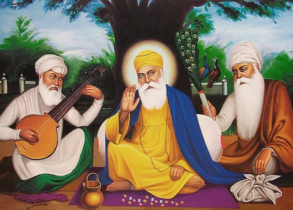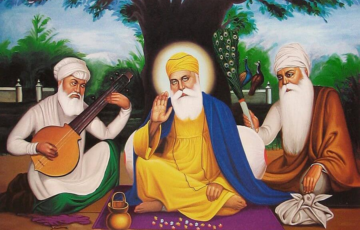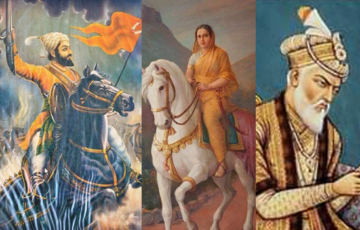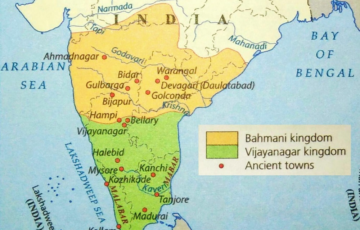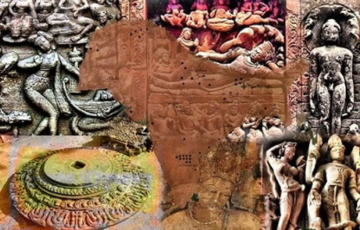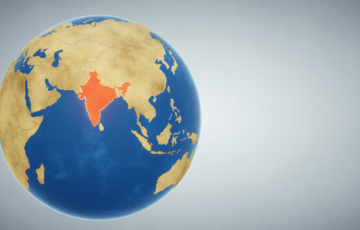THROUGH THE EYES OF TRAVELLERS
Al-Biruni: Insight into Indian Culture and Sciences
Introduction
- Birth and Proficiency:Born in 973 AD in Khwarizm, proficient in Syriac, Arabic, Persian, Hebrew, and Sanskrit.
- Settlement in Ghazni: Moved to Ghazni during Sultan Mahmud’s invasion of Khwarizm in 1017, allowing him to study Sanskrit and Indian culture deeply.
Translations and Studies
- Sanskrit Translations:Translated Sanskrit texts on astronomy, mathematics, and medicine into Arabic, including Patanjali’s grammar.
- Translation Challenges:Found Sanskrit challenging due to its vast vocabulary and complex grammar.
- Greek to Sanskrit:Translated works of Greek mathematician Euclid into Sanskrit.
Kitab-ul-Hind (Tahqiq-i-Hind/History of India)
- Comprehensive Text:Covers religion, philosophy, astronomy, alchemy, customs, social life, laws, and metrology.
- Caste System Observations:Based on Vedas, Puranas, Bhagavad Gita, and Manusmriti; noted the social divisions but disapproved of the concept of pollution.
Origin of the Term “Hindu”
- Persian Origin:Term from Old Persian for regions east of the Indus River; Arabs referred to the people as “Hindi.”
- Evolution of the Term:Used by Turks to denote people east of the Indus, with “Hindustan” for their land and “Hindavi” for their language, not initially indicating religious identity.
Ibn Battuta: A Glimpse into 14th Century Indian Life
- Birth and Travels:Born in Tangier, Morocco; traveled extensively across the Middle East, Africa, and Asia, valuing experiential knowledge.
- RIHLA: His book of travels provides insights into the subcontinent’s social and cultural life in the 14th century.
Service and Exploration
- Arrival in Sind:Reached Sind in 1333, drawn by Muhammad bin Tughlaq’s patronage.
- Service in Delhi:Appointed as qazi of Delhi; later sent as an envoy to the Mongol ruler in China.
- Extensive Travels:Explored central India, the Malabar coast, the Maldives, Sri Lanka, Bengal, Assam, and Sumatra, reaching China and eventually returning to Morocco.
Observations
- Coconut and Paan:Described unfamiliar plants like coconut and paan, noting betel leaves’ cultivation.
- City Descriptions: Detailed accounts of Delhi and Daulatabad, highlighting their size, gates, and marketplaces as centers of economic, social, and cultural activities.
Prosperity and Trade
- Agricultural Productivity:Noted the high productivity of Indian agriculture and the cultivation of two crops annually.
- Trade Networks: India’s integration into inter-Asian trade networks, with a high demand for Indian textiles.
- State Facilities:Mentioned efficient postal systems, inns, and guesthouses along trade routes.
- Slavery:Observed the prevalence of slavery, with slaves being sold in markets and given as gifts.
François Bernier: Insights into the Mughal Empire
- Background:A French doctor, political philosopher, and historian who explored the Mughal Empire from 1656 to 1668.
- In India: Arrived under the protection of Daneshmand Khan, serving as a physician to Prince Dara Shukoh and traveling with the Mughal army.
- Contributions: Authored “Travels in the Mughal Empire,” offering detailed observations and critiques, dedicated to King Louis XIV of France.
Comparing East and West
- Observations:Bernier drew comparisons between India and Europe, often criticizing India as the “degenerate East.”
- Women’s Treatment: Noted practices like Sati and women’s participation in labor, pointing out their greater public roles compared to their European counterparts.
- Land Ownership:Highlighted the absence of private land ownership in Mughal India, contrasting significantly with European practices.
Impact and Influence
- Influential Thoughts: His writings influenced Montesquieu’s concept of oriental despotism, shaping Western perceptions of the East.
Complex Social Reality
- Artisanal Stagnation: Artisans faced a lack of incentives for improvement, with the state appropriation of profits.
- Manufacturing Decline: Reported a downturn in manufacturing despite a thriving long-distance trade merchant community.
- Precious Metals Influx:Noted significant imports of precious metals into India in exchange for goods.
- Urban Demographics: During the 17th century, 15% of the Indian population lived in urban areas, surpassing proportions in Western Europe.
- Mughal Cities: Described as “camp towns” dependent on imperial patronage, lacking sustainable social and economic structures.
- Diversity of Towns: Identified various town types including manufacturing, trading, port towns, sacred centers, and pilgrimage towns.
Jean-Baptiste Tavernier
- Gem Trader and Traveller:Noted for discovering or purchasing the Tavernier Blue diamond in 1666, Tavernier detailed Indian diamonds and mines, visiting India at least six times.
| Period (Century) | Timeline | Related Rulers | Travellers (Country) |
| 7th Century | 630-645 AD | Harsha | Xuanzang (China) |
| 11th Century | 1017 AD | Mahmud of Ghazni | Al-Biruni (Persia) |
| 14th Century | 1333-1347 AD | Muhammad bin Tughlaq | Ibn Battuta (Morocco) |
| 15th Century | 1404-1414 AD | Timur’s Invasion | Niccolò de’ Conti (Italy) |
| 16th Century | 1524-1525 AD | Babur | Ludovico di Varthema (Italy) |
| 16th Century | Late 16th Century | Akbar | Ralph Fitch (England) |
| 17th Century | 1626-1668 AD | Jahangir and Shah Jahan | Peter Mundy (England) |
| 17th Century | 1634 AD | Shah Jahan | Jean-Baptiste Tavernier (France) |
| 17th Century | 1665-1666 AD | Aurangzeb | François Bernier (France) |
| 17th Century | 1670s | Aurangzeb | John Fryer (England) |
UPSC PREVIOUS YEAR QUESTIONS
1. According to Portuguese writer Nuniz, the women in Vijayanagara Empire were expert in which of the following areas? [2021]
1) Wrestling
2) Astrology
3) Accounting
4) Soothsaying
Select the correct answer using the code given below
a) 1, 2 and 3 only
b) 1, 3 and 4 only
c) 2 and 4 only
d) 1, 2, 3 and 4
Answer d
2. Which one of the following foreign travellers elaborately discussed about diamonds and diamond mines of India? (2018)
(a) Francois Bernier
(b) Jean-Baptiste Tavernier
(c) Jean de Thevenot
(d) Abbe Barthelemy Carre
Answer b
3. Persian literary sources of mediaeval India reflect the spirit of the age. Comment. (2020)
4. Assess the importance of the accounts of the Chinese and Arab travellers in the reconstruction of the history of India. (2018)


